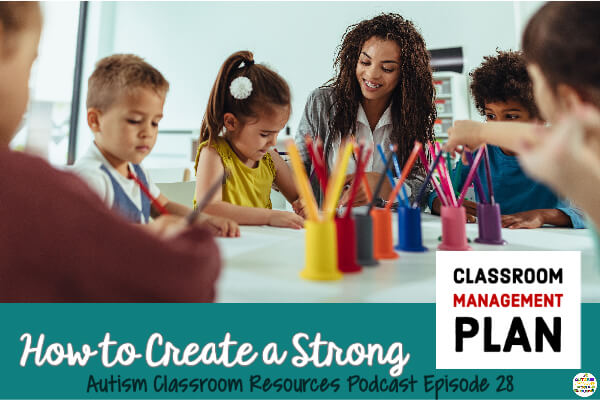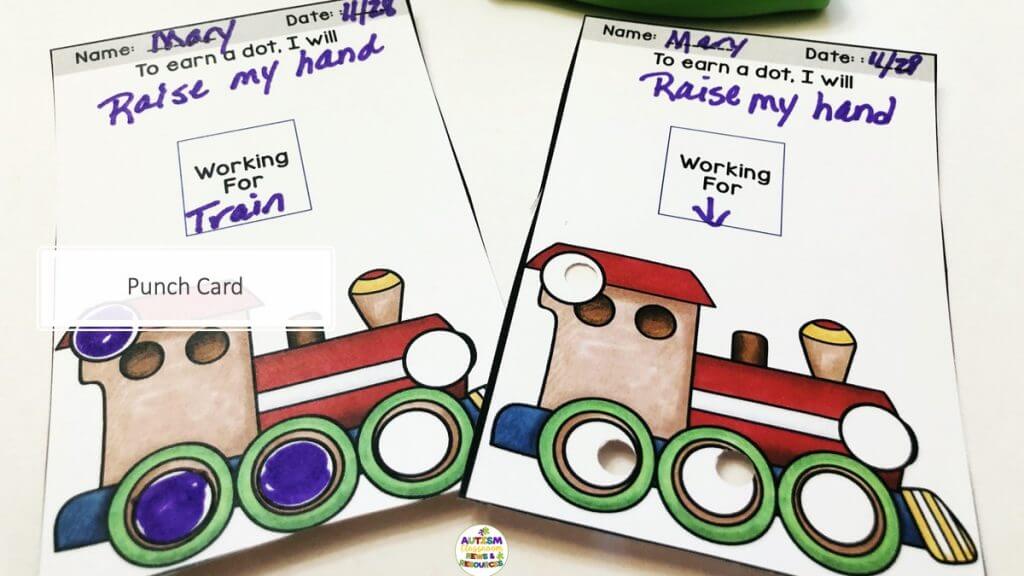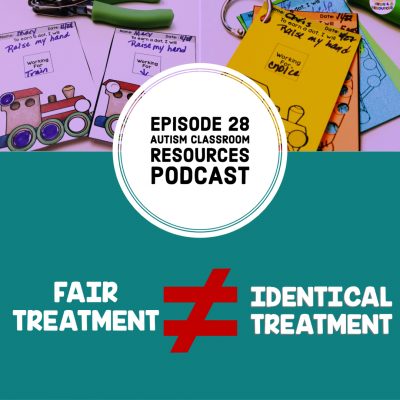Ep. 28: How to Create a Strong Classroom Management Plan

Resources
Steps in Creating Strong Classroom Management Systems

Now, for some, in some classrooms, you’re going to need more individual systems. So you might use something like punch cards. Everybody everybody gets different levels of punches or different levels of reinforcers for different students. So Sally needs 10 punches and Zion needs eight, because he’s not going to be able to make it to 10 and be successful. But regardless of what system you’re using, good, behaviorally sound classroom management systems have some elements in common. These should be in place regardless of how you’re setting it up.
1. Clear Sets of Routines and Procedures
The first element is that you really want to make sure you have a clear set of routines and procedures. I talked about this when I talked about preventive strategies in an earlier episode. But every group classroom management system should include what specific behaviors are being reinforced. And if you’re using negative consequences, you need to specify specifically what those consequences will be and which behaviors will they follow. So it’s important to teach these as well. Don’t simply have them posted. Actually teach them what it means to walk quietly in the hallway, what it means to make good choices.
So many times I hear people say, “Oh, that was a green choice,” or, “That was a red choice.” If we never taught them what a green or red choice meant, that is an absolutely meaningless statement. You will know that when you walk up to someone in the grocery store who is not in your classroom and you say that to them. They will look at you like you’ve lost your mind. So you want to make sure that you are teaching what those behaviors are that get reinforcement. And make it clear what the behaviors are that will result in negative consequences.
2. Reinforcement for Appropriate Behavior
The more the classroom management system is based on reinforcement for positive behavior, the more you will see positive behavior. We’ve talked in the last few episodes about positive reinforcement and its incredible power to make more positive things happen in the classroom.
It serves two functions. First, reinforcing positive behavior increases it, thereby leaving less time for negative behavior. Second, it holds up the positive model to the other students to emulate. You could use group contingencies, like a marble jar, where the whole class earns reinforcers for amassing marbles for positive behavior or individualized systems like token boards or stores.
So here’s the thing. If you’re using a system where the student’s negative behavior is what’s being called out and the positive behavior is just expected, the model that you end up holding up for the other students is look what happens when you misbehave. When you misbehave, people pay attention. But when you behave, because we just expect it, nobody does a thing. So positive reinforcement serves to help you by holding up for the rest of the students a model of what you want them to do, instead of a model of what you really don’t want them to do. They can’t always tell the difference.
3. Consistent Ability to Reach the Reinforcers
The students need a consistent ability to reach the reinforcers. Your classroom management system will be ineffective for any student who routinely fails to reach the reinforcer. If the student never reaches the reinforcer, then he fails to learn the consequence for positive behavior. So not only will his positive behavior not increase since it wasn’t reinforced, but he’s also less likely to buy into the system. And he may actively thwart it in order to get a predictable consequence.
Because as people, we tend to abhor a vacuum. And if we can’t figure out what makes things run, we’d rather have things be predictable (but maybe not always positive) than unpredictable and positive.
This means that you’re going to need to be able to differentiate the system for different students. Different students need different numbers of points or tokens to get to the reinforcer so that he will be successful. Because not every 8-year-old is going to be able to earn the same number of tokens during a day that every other 8-year-old can. You want to make sure that you can individualize it.

It’s Not About Fairness
Now, there will be folks who will say to you, “But that’s not fair.” Okay, it’s not, and neither is the rest of the world. What we’re trying to do is not be equal, not be fair. We are trying to have a level playing field so that everybody learns. Our goal in a classroom should not be to do the same thing for everybody because we think that’s fair. It should be to do what each student needs so that they can learn regardless of whether we’re teaching general ed or special ed. So I just reject the whole it’s not fair thing. It just doesn’t work for me.
4. The Ability to Recover Losses
Have you ever had a student who quickly figured out how many more stickers or tokens he needed before he got reinforced? He could look at his token board or look at his sticker card and realize that he’d blown it for the day. And when that happened, his behavior just deteriorated even more. You want a system where a student can still come back for the day. Or one that he can carry over the points and tokens to the next day so he has a continuing incentive to try even if he messed up.
Think about when you’re on a diet. If you’ve ever tried to lose weight by being on a diet? Have you ever had a situation where it’s like, “Well, I ate the piece of pie. So now I might as well just eat everything I want because this just became a cheat day. And I’m going to eat my entire kitchen and just because I know I’ve blown it. I know that I’ve already gone past what I should have eaten for the day. So now I’m just going to eat everything because it’s not going to count anymore.” That’s what happens. And that’s not what we want to happen for our students.
You want the ability to recover. So consider having a system that’s fluid across days or a system that a student can earn more back to get to a positive. Doesn’t mean he has to get his reinforcer today. Maybe he carries his points over to tomorrow and can build on it for tomorrow. You can also build in systems where they can save points for a later day or things like that. That continues to make the points or the tokens meaningful so that they can continue to win even when they’ve screwed up.
5. In Classroom Management, If Students Lose, They Should Also Win
If students can lose on your system, if he can lose points, or lose stickers, or lose tokens, then he needs to be able to gain that loss back. Your system should be fluid and allow the student to move up and down. If you’re using a clip system, you want to make sure that you are allowing the students to recover if they fall towards the bottom. Once he gets down to the bottom and if he can’t come back up, why bother? Why keep trying? It’s exactly like the diet that you just blew. So if the student only moves down, it’s demoralizing. And they’re going to sabotage the system because it isn’t working for him.
Bonus: Praise Publicly
Now, I’m also a really big fan though of praising and reinforcing appropriate behaviors in public but correcting behaviors in private. I’m not a great fan of clip charts because I find that they kind of send up this public signal of this kid is being bad. And I also find that our students often get a self-fulfilling prophecy. I’m the bad kid in class, so I act like the bad kid in class because that’s what people expect from me. I get a predictable response, maybe not positive, but predictable when I do that. And the kids who struggle with behavior are typically the kids who need the most support and don’t always understand why they’re at the bottom of the chart to begin with.
What About Clip Charts for Classroom Management?
So I find clip charts difficult. They can work as long as they’re fluid and as long as you find a way to differentiate with different standards to individualize for each student, because this student will not behave the same way as the student sitting next to him. They’re easy, and they’re visible. I just find it hard to figure out how I’m going to individualize them unless that whole class is easily motivated by praise and internal reinforcement. So while internal motivation is what we’re going for, as I said in our myths about reinforcement, it cannot be where we start.
Everyone is an Individual
Whether your student has autism, a behavior disability, or is just a typical student who needs more structure, whatever it is, those are all students who are going to need an individualized system. It can be a group system. It can be a system that goes across the class with individualization for what’s expected.
So maybe one student needs to follow four rules and another student needs to follow two rules. Will the students say, “How come I have to follow four rules and he has to follow two?” Yes. Is that an opportunity to explain what fairness means? Yes.
It always happens with my students with autism. Someone will say, “But it’s not fair that he has to do something different than … He gets to do something different than everybody else.” And I’m like, “I’m sorry. Was it fair that he has autism? I don’t think so.” So you really kind of want to think about that.
Summary and Free Tools
But I think the main things I really want to get across are that your students need to be able to win and recover when they lose. They need to be able to have consistent ability to reach the reinforcers on a regular daily basis or more than daily basis. We really want to make sure that we are focusing on reinforcement for appropriate behaviors, and we want to make sure that we have clearly defined those routines and procedures that we are using reinforcement for.
Don’t forget to grab your free tools, including visual rules, token boards and punch cards to get your classroom systems going. If you’re interested in learning more about behavior, how to manage behavior, all those kinds of things, we have a ton of opportunities for that in the Special Educator Academy. If you have questions for me, I try very hard to answer as many emails as I can, but I can’t get to all of them. But I do answer everyone in our community in the Special Educator Academy. That is where I hang out at least twice a day. It gives us an opportunity to discuss individualized issues related to behavior as well as access resources on behavioral support. You can find more information about that at specialeducatoracademy.com.






